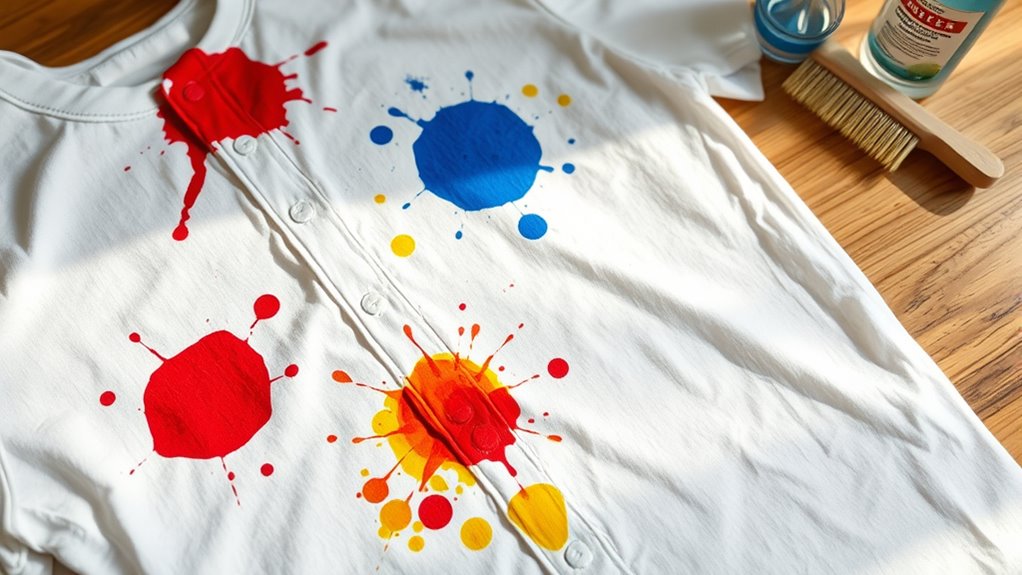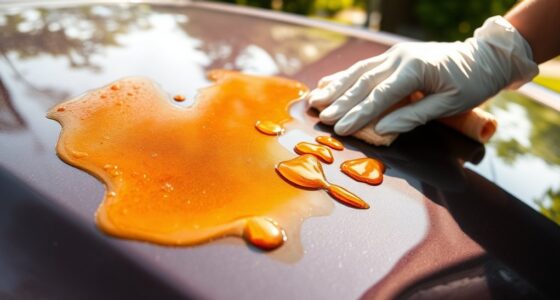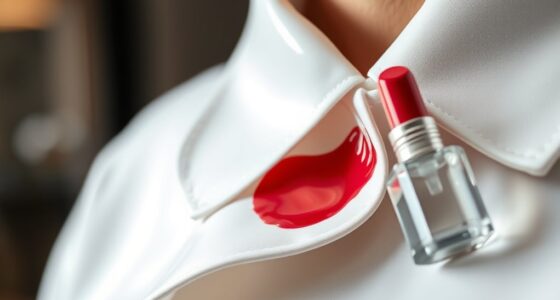Got paint stains on your clothes? Don’t worry! Start by blotting the excess paint with a cloth and gently scrape off any residue. Rinse the stained area under cold water to stop the paint from setting. For fresh stains, rub in liquid laundry detergent. If the paint’s dried, soaking or using solvents like rubbing alcohol can help. Different types of paint may require specific methods, so there’s more to discover about effective cleanup strategies.
Key Takeaways
- Identify the paint type (water-based or oil-based) to choose the most effective removal method.
- Blot excess paint immediately and rinse the stained area under cold water to prevent setting.
- For fresh latex stains, apply liquid laundry detergent and work it into the fabric.
- Use solvents like rubbing alcohol for acrylic stains and paint thinner for oil-based paints, testing on a hidden area first.
- Treat stains promptly for the best chance of complete removal; consider enzyme-based detergents for stubborn stains.
Understanding Paint Stains

When you encounter a paint stain on your clothes, understanding the type of paint involved is essential for effective removal. Water-based paints, like latex and acrylic, are generally easier to tackle than oil-based paints, which require solvents for removal. Recognizing the paint’s composition can guide your approach: water-based paints contain water and emulsifiers, while oil-based ones consist of solvents and oils. Additionally, the paint’s use, such as tempera or finger paint, can also affect the removal process. Different methods are necessary for each type, so identifying whether it’s oil or water-based helps you choose the best solvent or technique. This knowledge sets the stage for successful stain removal, as identifying paint types is crucial for selecting the appropriate cleaning method.
Immediate Actions to Take

To effectively tackle a paint stain, acting quickly is essential. Start by blotting the stain with a clean cloth or paper towel to absorb any excess paint. Then, use a blunt knife or spoon to gently scrape off additional paint. Rinse the stained area under cold running water to help prevent the paint from setting. For fresh stains, apply a small amount of liquid laundry detergent and work it into the fabric gently. If the paint has dried, scrape off as much as you can, soak the area in warm water, and consider using solvents like rubbing alcohol for oil-based paint. Always check the fabric care label to avoid damage while treating the stain. Using eco-friendly detergent strips can enhance your stain removal efforts while promoting sustainable laundry practices.
Common Household Remedies
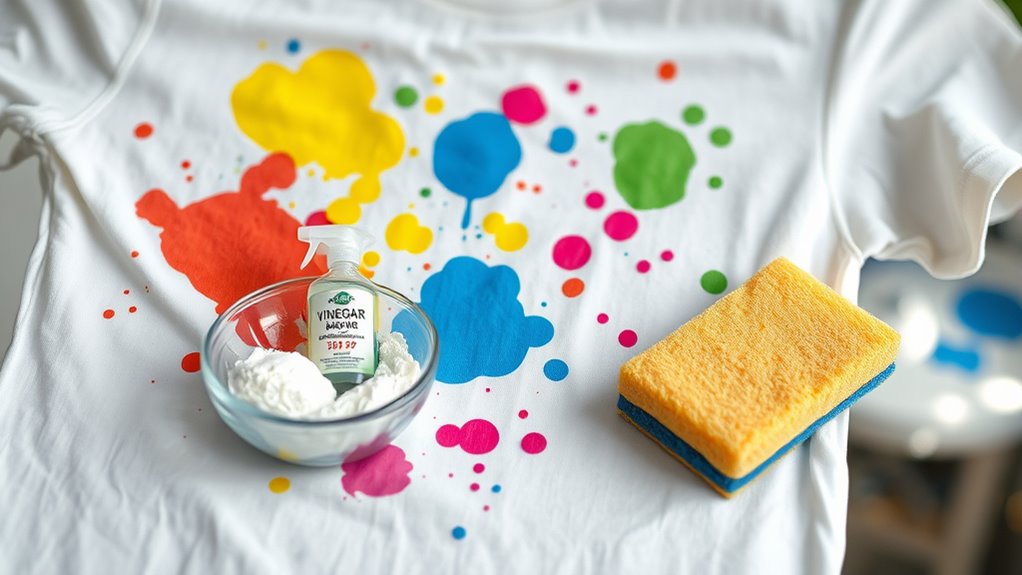
After taking immediate action to address paint stains, you can turn to common household remedies that often prove effective.
For latex paint, try using vinegar as a mild solvent or create a paste with baking soda to draw out the stain. It’s essential to treat stains quickly for the best chance of removal.
If you’re dealing with fresh acrylic paint, warm water or dish soap can work wonders. Rubbing alcohol and hand sanitizer are also good options for breaking down acrylic paint.
For oil-based paint, paint thinner is your best choice, but be cautious. You can also use boiling water to loosen the paint.
Always remember to test any remedy on a hidden area first to avoid damage.
With these household items, you have a fighting chance against those pesky paint stains!
Laundry Detergent and Commercial Products
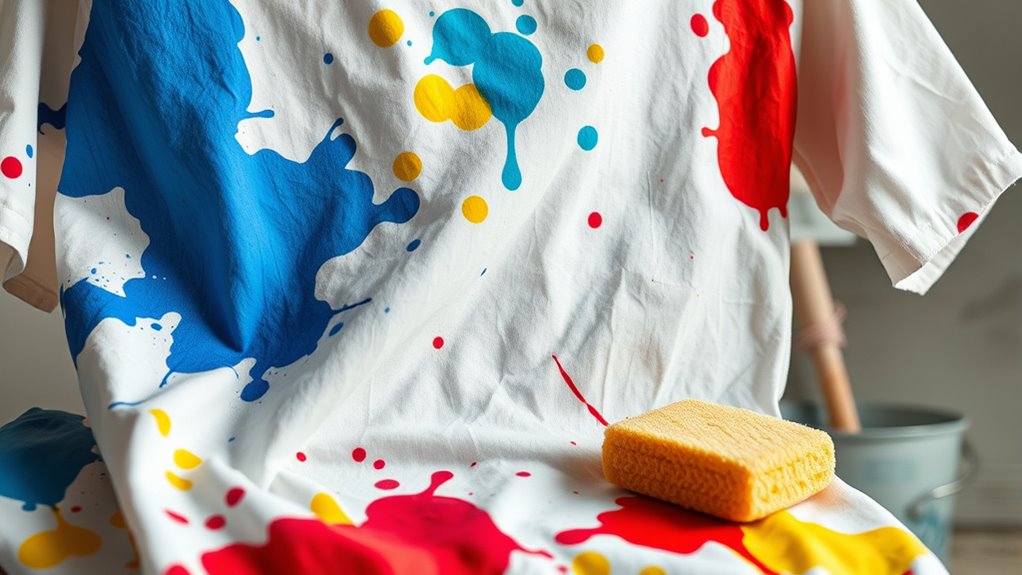
While you might’ve tried various household remedies for paint stains, laundry detergents and commercial products can provide a more targeted approach for effective stain removal.
Enzyme-based detergents are particularly powerful against paint, breaking down complex stains by targeting proteins and fats. Heavy-duty formulas, like Tide Ultra Stain Release and Persil ProClean, excel at tackling tough paint stains. Detergent stains can also occur if the detergent is not properly dissolved during the wash cycle, so it’s important to follow dosing instructions carefully. Additionally, using lightweight formulations can help prevent residue buildup during the cleaning process.
For eco-conscious consumers, Kind Laundry Detergent Sheets offer an effective, environmentally friendly option. Always follow dosing instructions to avoid buildup, and pre-treat stubborn stains by applying detergent directly to the area before laundering.
Remember to check fabric care labels to guarantee compatibility with your chosen detergent, as this can enhance your stain removal success.
Solvents for Paint Removal

When dealing with paint stains, choosing the right solvent can make all the difference in effective removal.
For oil-based paints, turpentine or paint thinner works best, but handle them with care due to their strong odors and flammability. Quick action is crucial for stain removal effectiveness, so address the stain as soon as possible.
If you’ve got dried latex paint, acetone is your go-to, although it may damage certain fabrics. Isopropyl alcohol effectively tackles acrylic stains, while nail polish remover can be useful for latex, too—just test it first on a hidden area.
Always prioritize safety by working in a well-ventilated space, wearing gloves, and eye protection. Remember to blot rather than rub the stain, and use paper towels underneath to absorb excess solvent and paint.
Special Considerations for Different Fabrics

Understanding the specific needs of different fabrics is essential for effectively removing paint stains. For cotton, you can usually treat water-based paint easily, while wool requires a gentle approach to avoid damage.
Linen’s natural fibers may shrink, so wash at controlled temperatures. Synthetic fabrics like nylon and polyester are durable but may need special handling for oil-based stains.
Silk, being delicate, often needs specialized cleaning products to prevent harm. Always pre-treat stains and choose high-quality detergents for better results.
Use cooler water for delicate fabrics, and remember to spot test any cleaning agents first. Following care labels guarantees you’re taking the right steps for each fabric type, maximizing your chances of successful stain removal.
Frequently Asked Questions
Can Paint Stains Be Removed From Upholstery?
Yes, you can remove paint stains from upholstery, but it depends on the paint type.
For latex paint, warm water and dish detergent usually work well.
Oil-based paints are trickier; you might need turpentine or paint thinner.
Always scrape off excess paint first, and remember to test any cleaning solution on a hidden area to avoid damage.
If the upholstery is delicate, professional cleaning is your safest bet.
How Can I Prevent Paint Stains While Painting?
Oh sure, you want to avoid paint stains while painting? What a novel idea!
To keep your clothes clean, wear old garments and use protective gear like gloves and aprons. Cover your workspace with drop cloths and remove any clutter that could lead to chaos.
Keep pets and kids away, and guarantee good ventilation. And remember, cleaning as you go will save you from a messy aftermath.
Who knew painting could be so tidy?
Are There Any Eco-Friendly Paint Removal Options?
If you’re looking for eco-friendly paint removal options, you’ve got several choices.
Try using eco-friendly laundry detergent strips by soaking them in warm water and applying them with a cloth. Hand sanitizer and rubbing alcohol can also be effective for stains.
Vinegar and baking soda paste serve as great alternatives too.
Always remember to spot test first, and check the care label to guarantee your fabric’s safety during the process.
What Should I Do if Paint Dries Overnight?
Did you know that about 10% of all laundry stains are paint-related?
If paint dries overnight, don’t panic. Start by scraping off any excess paint with a dull knife.
Then, apply rubbing alcohol or a suitable solvent directly to the stain and let it sit for a few minutes.
Gently scrub the area, and rinse it with cold water.
Remember to test any products on a hidden fabric area first!
Can I Use Vinegar for Paint Stain Removal?
Yes, you can use vinegar for paint stain removal, especially if you’re dealing with water-based paints like latex or acrylic.
It effectively loosens the bond between the paint and fabric. Just remember to test it on a hidden area first to guarantee it won’t damage your fabric.
If the stain persists, try mixing vinegar with laundry detergent for better results.
Always rinse thoroughly with cold water after your treatment.
Conclusion
So, you’ve tackled those pesky paint stains and—surprise!—you’ve found a method that actually works. Who knew that a simple household item could save your favorite shirt? By staying calm and following the right steps, you can turn a potential disaster into a success story. Keep these tips handy for the next time creativity strikes, because you never know when a paint project might lead to an unexpected wardrobe rescue!
